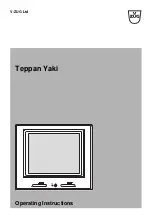
6
INSTALLATION
Installation and maintenance must only be
carried out by a qualified installer.
Incorrect installation could cause damage to
persons, animals and property for which the
manufacturer cannot be held responsible.
4) INSTALLING THE HOT PLATE
Check that the appliance is in a good condition
after having removed the outer packaging and
internal wrappings from around the various loose
parts. In case of doubt, do not use the appliance
and contact qualified personnel.
Never leave the packaging materials
(cardboard, bags, polystyrene foam, nails, etc.)
within children's reach since they could
become potential sources of danger.
The measurements of the opening made in the top
of the modular cabinet and into which the hot plate
will be installed are indicated in either fig. 3, comply
with the measurements given for the hole into which
the appliance will be recessed (see fig. 4).
If a wood is installed above the hob, please look at
the hood manufacturer instructions regarding the
minimum distance between hood and hob (fig. 4).
5) FIXING THE HOT PLATE
The hob has a special seal which prevents liquids
from infiltrating into the cabinet. Strictly comply
with the following instructions in order to correctly
apply this seal:
- detach the seals from their backing, checking
that the transparent protection still adheres to the
seal itself.
- Overturn the hob and correctly position seal “E”
(fig. 5) under the edge of the hob itself, so that
the outer part of the seal itself perfectly matches
the outer perimetral edge of the hob. The ends of
the strips must fit together without overlapping.
- Evenly and securely fix the seal to the hob,
pressing it in place with the fingers and remove
the strip of protective paper from the seal and set
the plate into the hole made in the cabinet.
- Fix the hotplate to the worktop with the brackets
“S”. Ensure the tag fits into the hole “H” on the
hotplate base, then tighten the screw “F” until it is
locked to the worktop (fig. 6).
WARNINGS:
be aware that the glue that join the laminated
plastic to the furniture, has to resist to
temperature not below 150° C, to avoid the
unstuck of the panelling.
The rear wall, adjacent and surrounding
surfaces must therefore be able to withstand
an overtemperature of 65K.
FIG. 3
FIG. 4
FIG. 5
FIG. 6
A
B
C
D
E
2E
285
485
57.5
57.5 100 min.
COMPLY WITH THE DIMENSIONS
(mm)




























